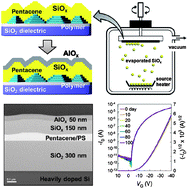Damage-free hybrid encapsulation of organic field-effect transistors to reduce environmental instability†
Abstract
Damage-free hybrid encapsulation layers have been fabricated and optimized to improve the structural reliability and operational stability of organic field-effect transistors (OFETs); this reduction in instability was systematically demonstrated under various environmental conditions. The introduction of a 150 nm thick SiOx layer onto 50 nm thick


 Please wait while we load your content...
Please wait while we load your content...